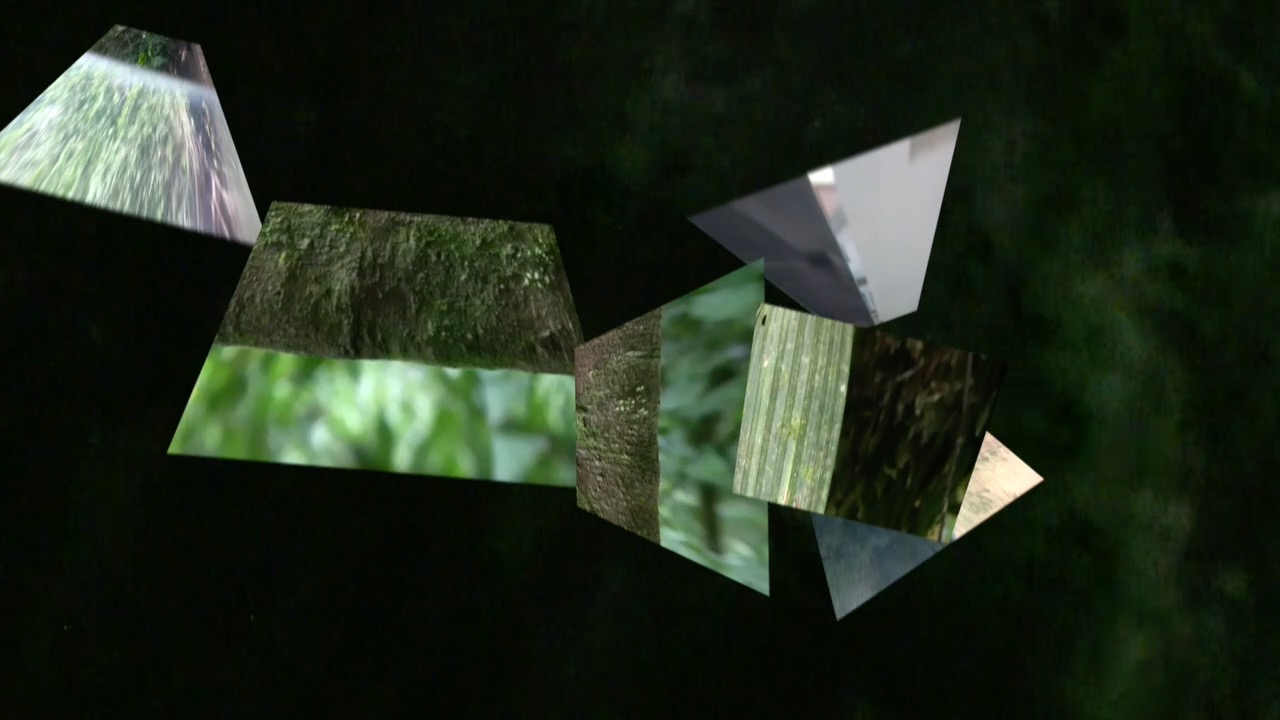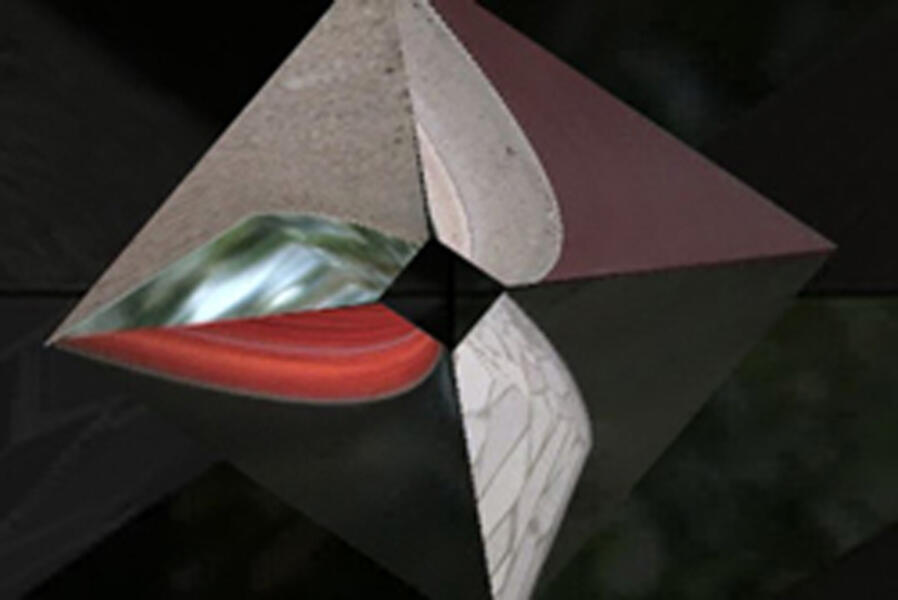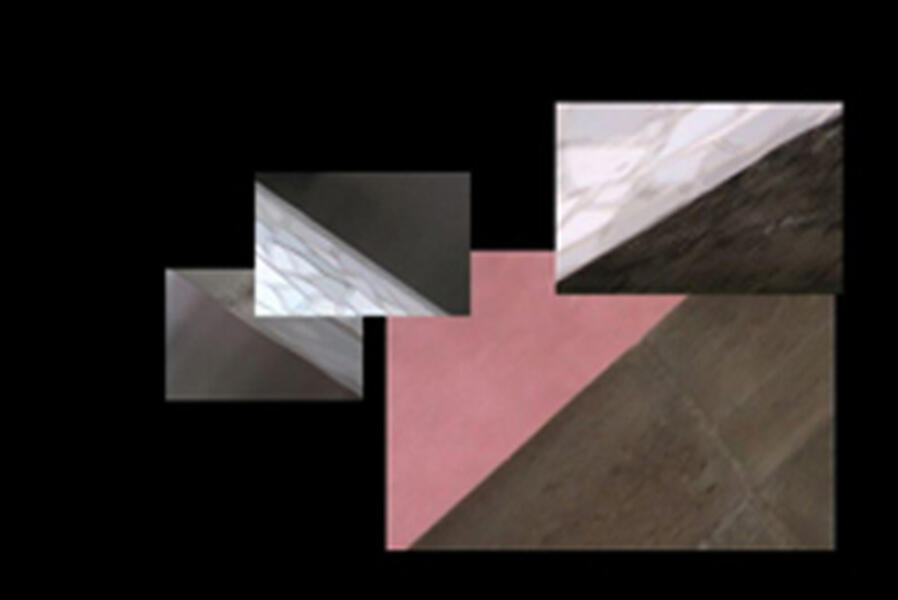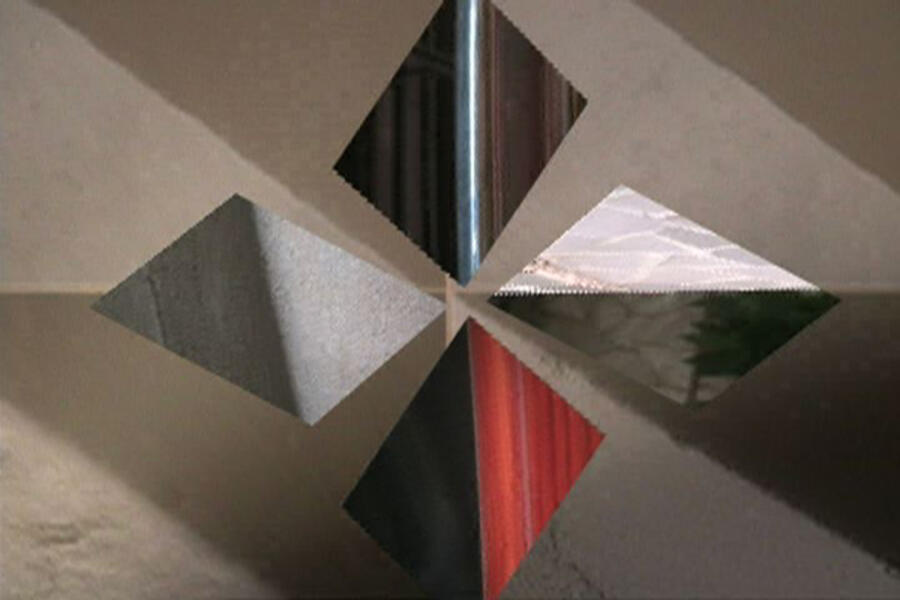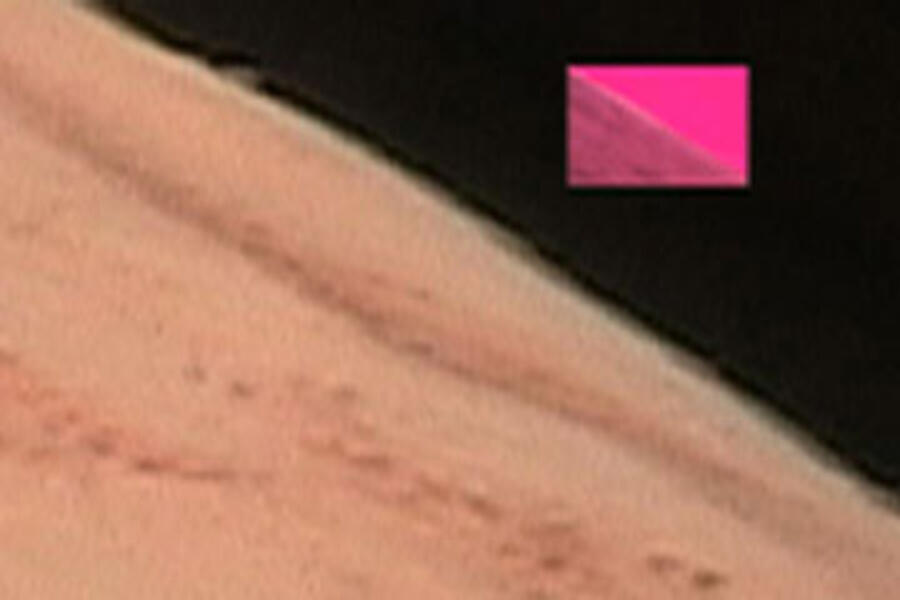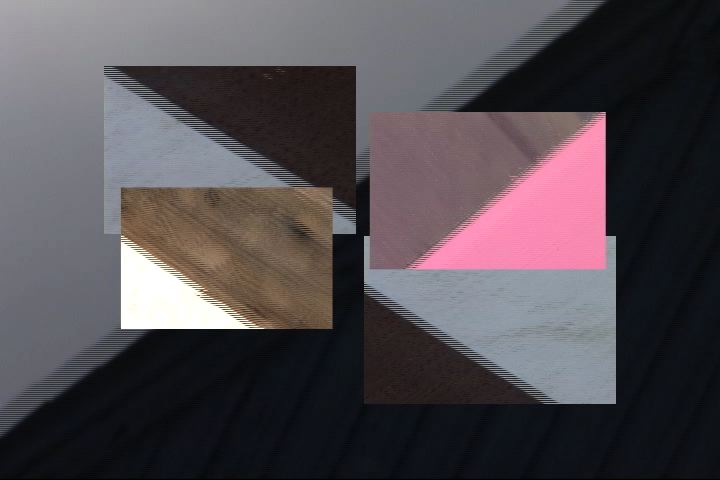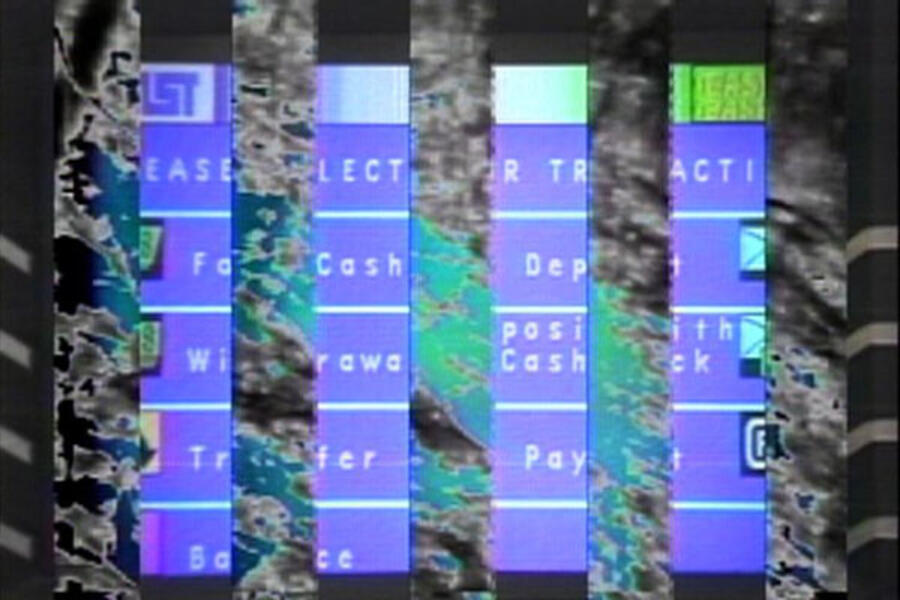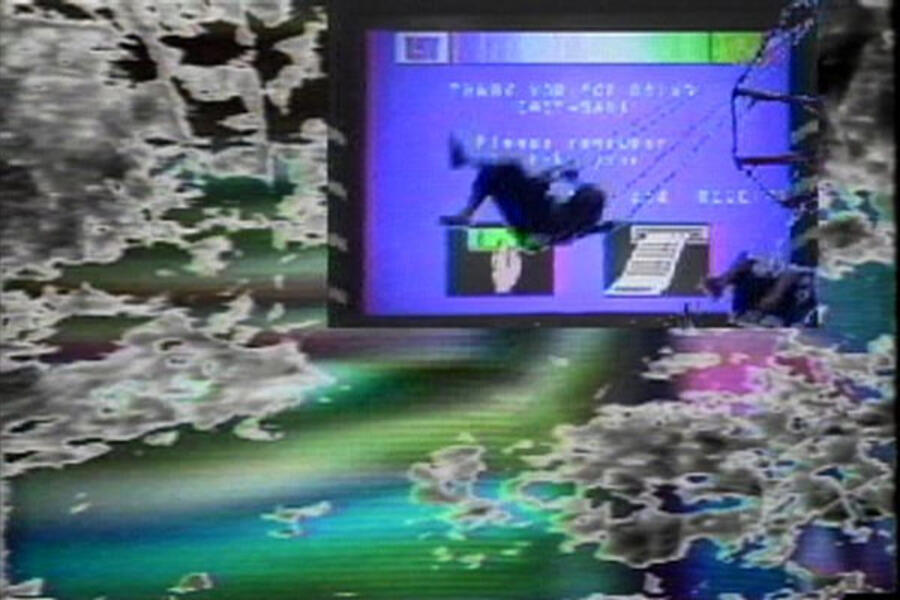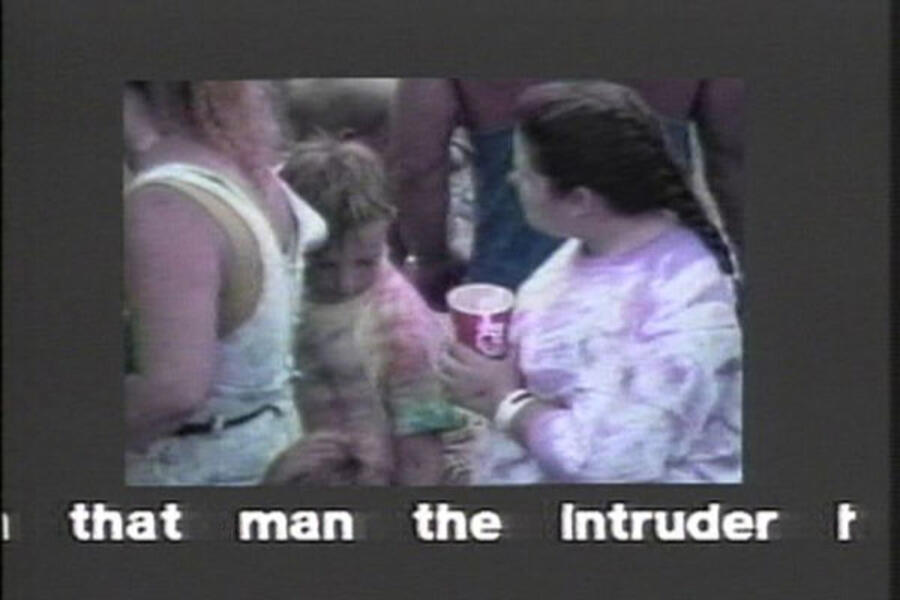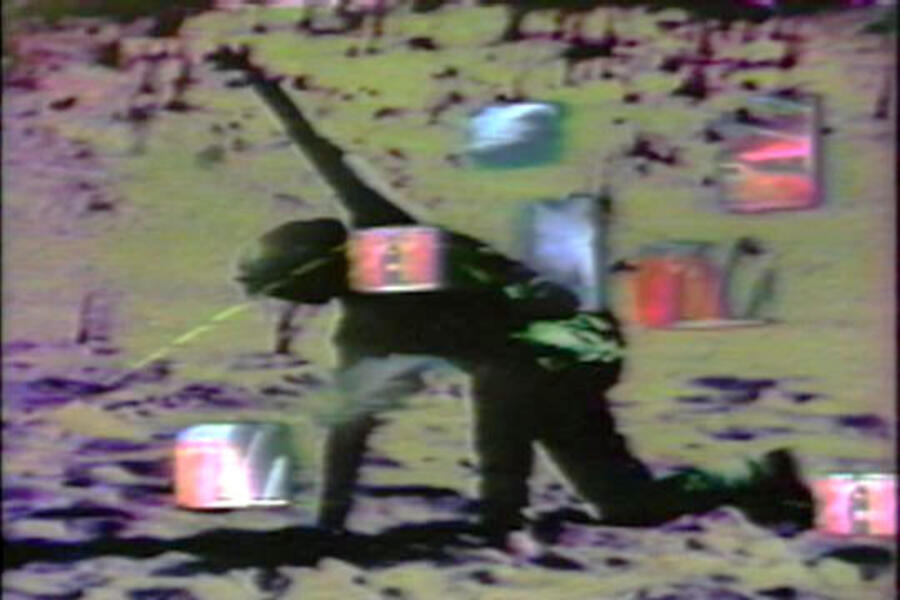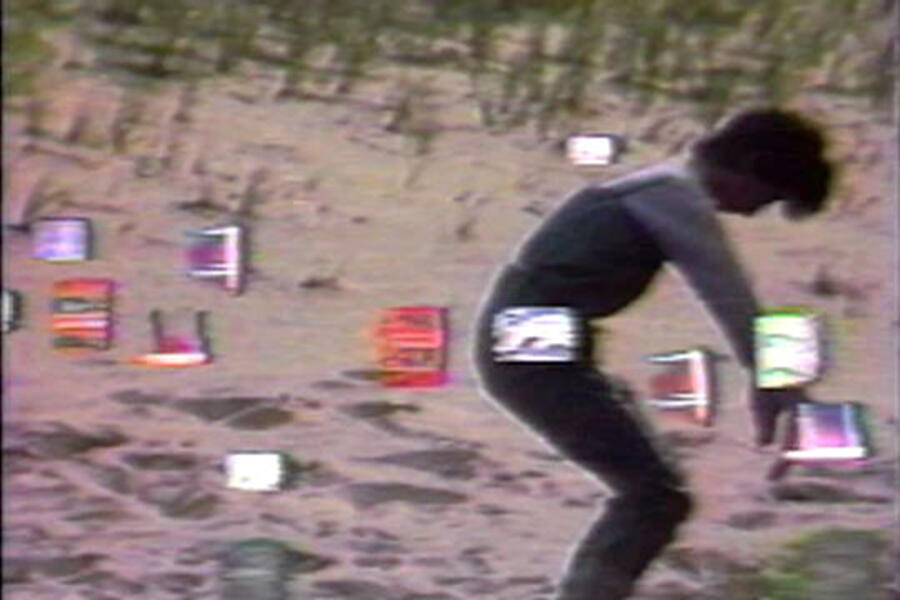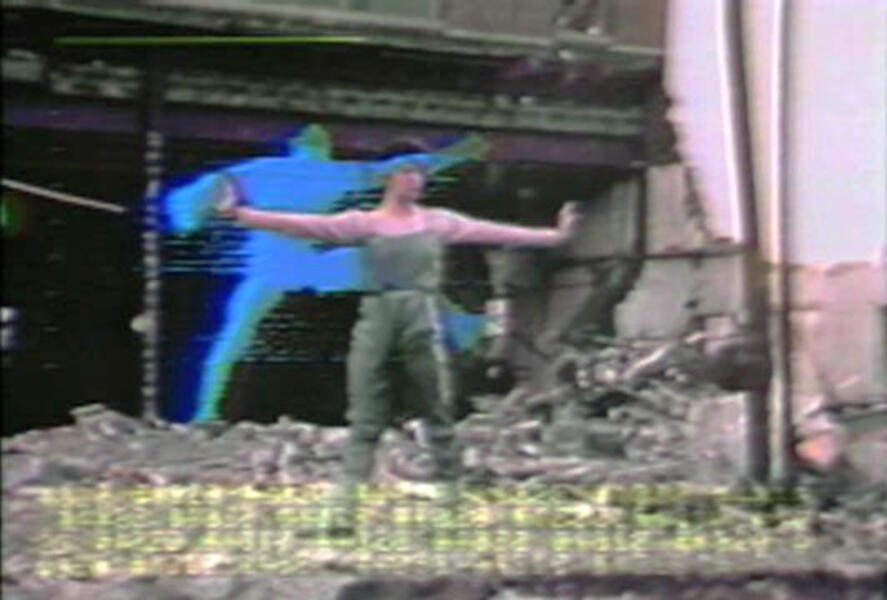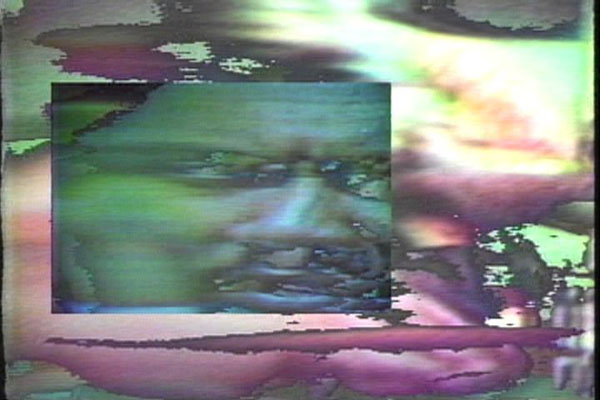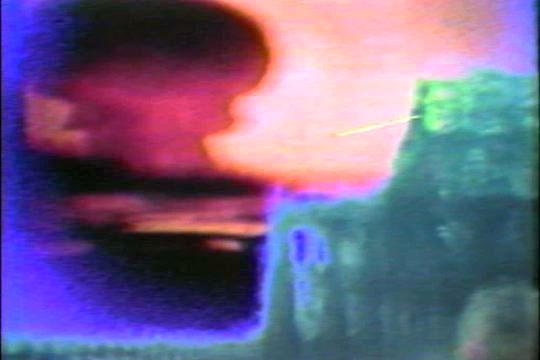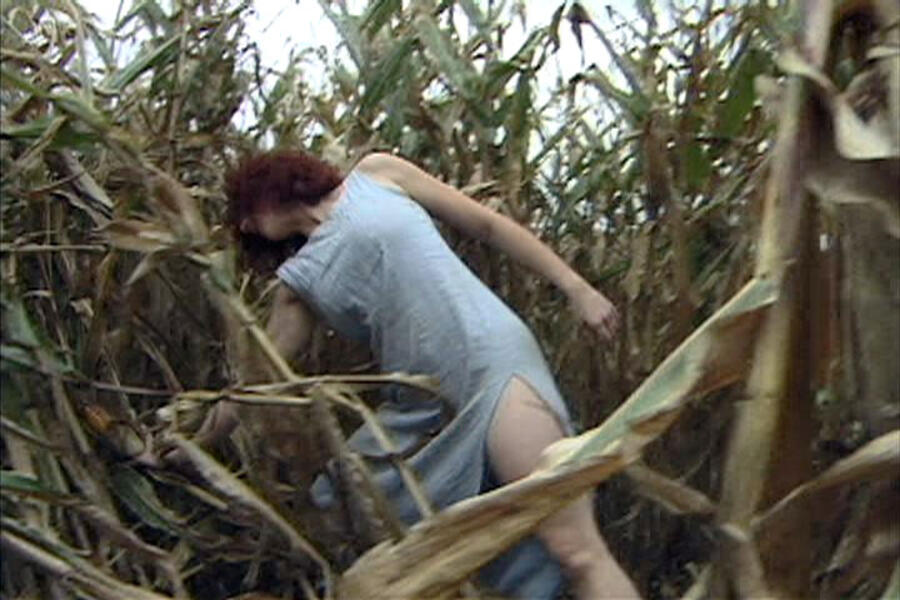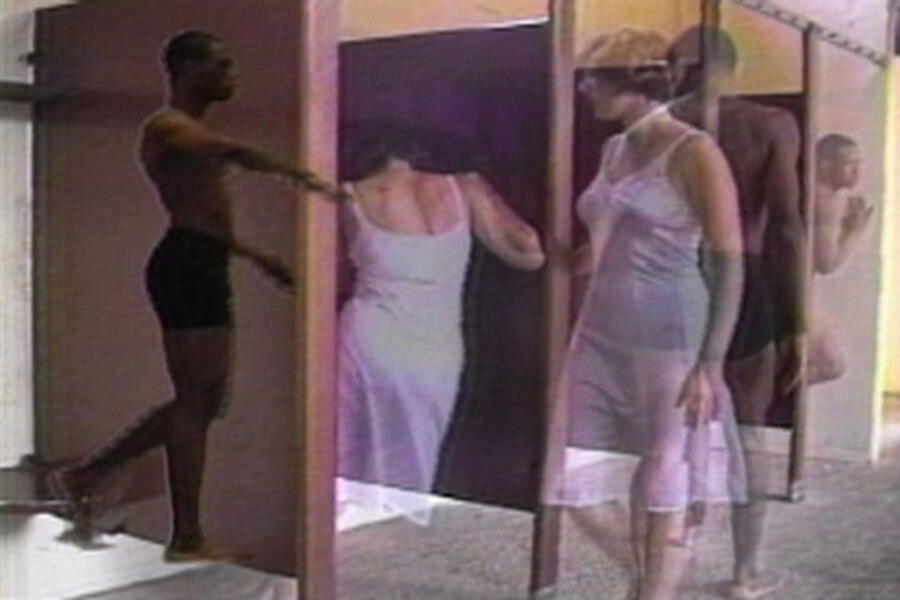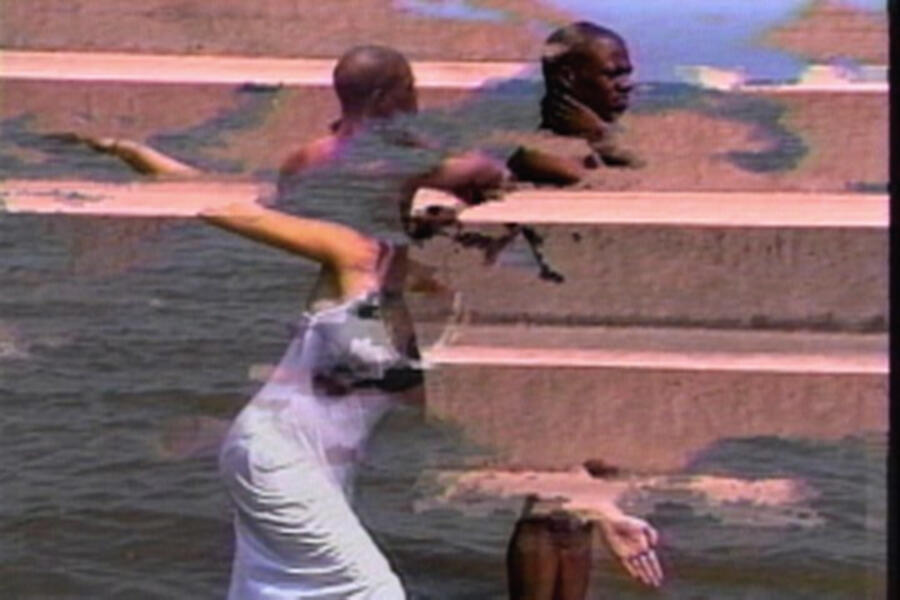Work samples
-
Sky Buy“Sky Buy” is an experimental video conceived as a dream collage. My intent was to arrange a set of images with all the logic and shifting pacing of a dreamscape. In the principal scenes, various artifacts of TV media are subjected to a forceful purifying water barrage. I collaborated with computer animator Francisco Olivares to create a waterspout sequence designed to overwhelm a series of abstracted scenes drawn from commercial media. A second animated water sequence depicts the flooding of the physical detritus of our media infrastructure. Additional footage includes night driving, two plazas in Madrid, an ocean buoy, driving in the rain, and a Klezmer band. Elliott Grabill provided principal sound/music sequences.
-
11 Time PaintingsI think of my video art as painting in time. “11 Time Paintings” presents a series of short visual music sketches produced utilizing a range of rhythmic editing techniques. The audio always originates with the original ambient sound recorded at the time the video was shot. My intent is to create a visceral effect where a distinct sound/image “brushstroke” occurs with each edit - no additional sound tracks are added.
-
"Frontier" (excerpt)My intent for “Frontier” was to create a visually-rich abstract environment by blending together a wide assortment of source footage, ranging from natural phenomena (water, sky, etc.), to rapidly-scanned street scenes, to manipulated faces shot off a television screen. Central to the visual field is a slowly moving window frame structure that allows for different visual sequences to be seen together, both inside and outside of the “window” cut outs.
-
The Inner Eye: From the Outside In (excerpt)
Poet Elizabeth Goldring and video artist Vin Grabill remember their video projects from the late 1980's in a conversation recorded at the Goldring-Piene Art Farm in Groton, MA, July 2024. (excerpt from 17-minute video)
About Vin
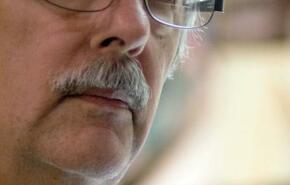
I began painting 50 years ago, and I switched primarily to working in video about 35 years ago. While I often return to painting, I remain fascinated with the power and flexibility of the video medium. As it advances technologically, video continues to provide me with the means to "paint in time". The impact and quality of the still image is still very important to me, however, and I choose to display many still frames from my videos here in these project arrays.
I've been… more
Recent Video I: 2013-2019
“Sky Buy” is an experimental video conceived as a dream collage. My intent was to arrange a set of images with all the logic and shifting pacing of a dreamscape. In the principal scenes, various artifacts of TV media are subjected to a forceful purifying water barrage. I collaborated with computer animator Francisco Olivares to create a waterspout sequence designed to overwhelm a series of abstracted scenes drawn from commercial media. A second animated water sequence depicts the flooding of the physical detritus of our media infrastructure. Additional footage includes night driving, two plazas in Madrid, a ringing ocean buoy, driving in a rainstorm, and an impromptu Klezmer band. Elliott Grabill provided principal sound/music sequences.
-
11 Time PaintingsI think of my video art as painting in time. “11 Time Paintings” presents a series of short visual music sketches produced utilizing a range of rhythmic editing techniques. The audio always originates with the original ambient sound recorded at the time the video was shot. My intent is to create a visceral effect where a distinct sound/image “brushstroke” occurs with each edit - no additional sound tracks are added. While abstract in a musical sense, vestiges of the locations where I shot my source footage remain, revealing references to Madrid traffic, Times Square, a jungle in Costa Rica, and other sites.
-
 11 Time Paintingsvideo still
11 Time Paintingsvideo still -
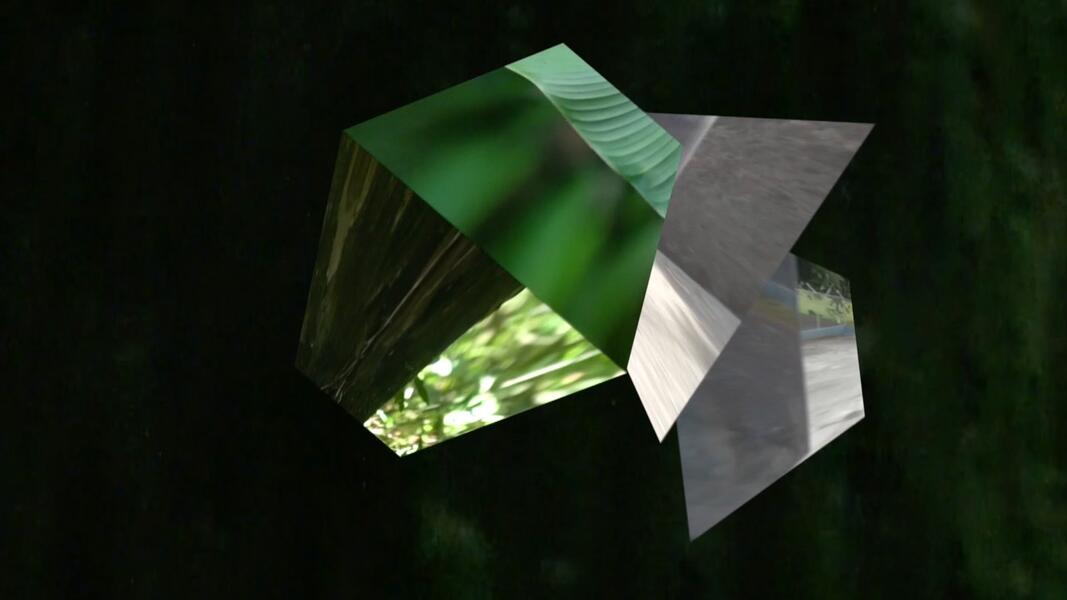 11 Tiime Paintingsvideo still
11 Tiime Paintingsvideo still -
Sky Buy“Sky Buy” is an experimental video conceived as a dream collage. My intent was to arrange a set of images with all the logic and shifting pacing of a dreamscape. In the principal scenes, various artifacts of TV media are subjected to a forceful purifying water barrage. I collaborated with computer animator Francisco Olivares to create a waterspout sequence designed to overwhelm a series of abstracted scenes drawn from commercial media. A second animated water sequence depicts the flooding of the physical detritus of our media infrastructure. Additional footage includes night driving, two plazas in Madrid, an ocean buoy, driving in the rain, and a Klezmer band. Elliott Grabill provided principal sound/music sequences.
-
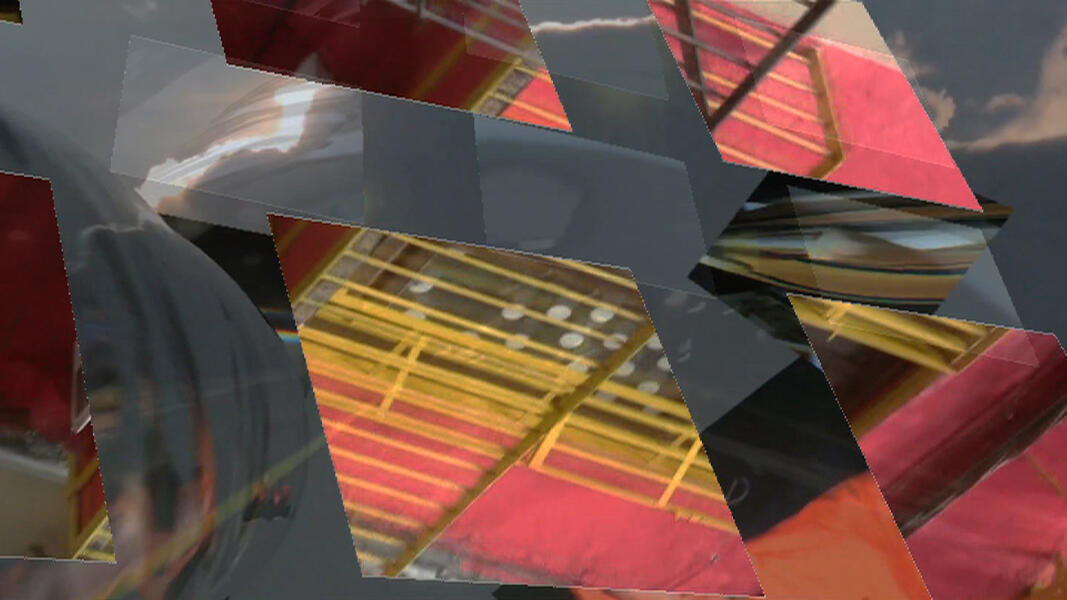 Sky Buyvideo still 2013
Sky Buyvideo still 2013 -
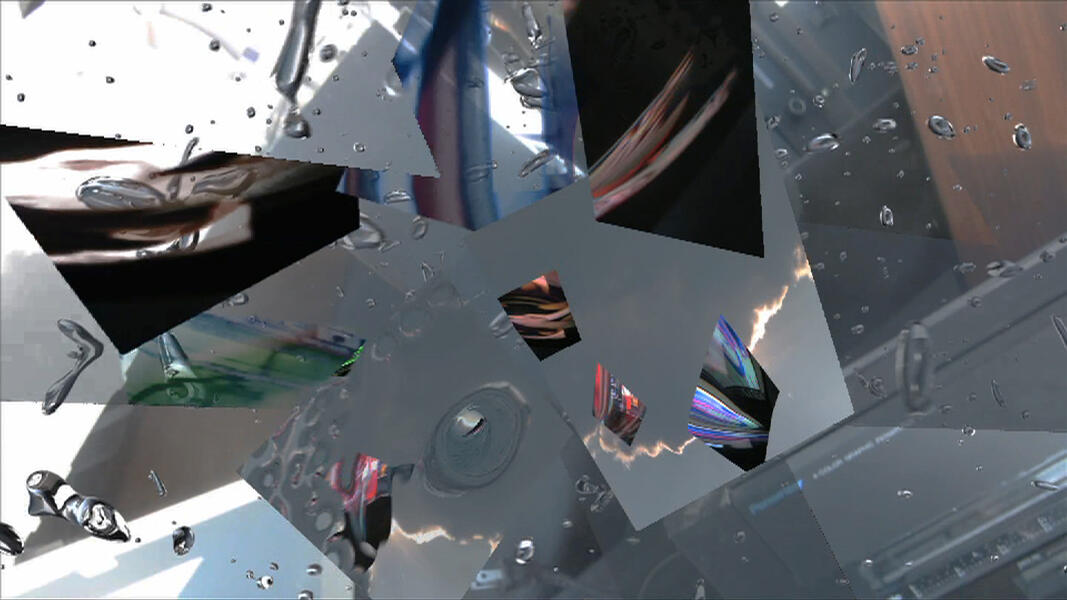 Sky Buyvideo still 2013
Sky Buyvideo still 2013 -
 Sky Buyvideo still 2013
Sky Buyvideo still 2013
Recent Video II: 2010-2012
"Wet" is an experimental video conceived as a dream collage. In the principal scenes, various artifacts of TV media are subjected to a forceful purifying water barrage. I collaborated with computer animator Francisco Olivares to create a waterspout sequence designed to overwhelm a series of abstracted TV scenes. A second animated water sequence depicts the flooding of the physical detritus of our media infrastructure. Additional interludes depicting wetness round out the video?s visual episodes.
My intent for "Frontier" was to create a visually-rich abstract environment by blending together a wide assortment of video imagery, ranging from natural phenomena (water, sky, etc.), to rapidly-scanned street scenes, to manipulated faces shot off a television screen. Central to the visual field is a slowly moving window frame structure that allows these various visual sequences to be seen together, viewed both inside and outside the animated ?window? openings, allowing for an ongoing figure/ground play of contrasting imagery. While these image pairings play out, additional visual elements eventually course across the picture plane like storms, sometimes obscuring the window frame structure beneath. I collaborated with Elliott and also Argentinian composer Martin Gendelman. The predominant soundtrack element derives from Elliott?s composition for chorus, "Hathors", in which Elliott channels vocalizations from an extraterrestrial people.
"Frontier" was selected for the "Catalyst: 35 Years of Washington Project for the Arts" exhibition at the American University Museum at the Katzen Center, Washington, D.C. in 2010. It was also exhibited at the 2011 Maryland Film Festival and the Athens International Film & Video Festival. And "Frontier" was selected for the "Under Cover" exhibition at the Decker Gallery at MICA, a project of the Exhibition Development Seminar, January 27-March 11, 2012.
"Kings Highway / Stillwell Ave., Brooklyn" started as a piece of music for piano written by Elliott. It was inspired by Elliott's "feeling sad about leaving New York City to move to Washington, D.C." Elliott took inspiration for this piece "from a dreary day in February when, visiting Brooklyn, I felt that everything had gone on without me."
I made a video recording of Elliott playing "Kings Highway" at a performance in Washington, D.C. in October 2010. Elliott provided several hundred digital photos he had taken during his time in New York, and together, Elliott and I decided how to edit these images in and around the performance video footage. "Kings Highway" was selected as a finalist in the 2011 Rosebud Film & Video Awards Competition.
"After the Storms" is a recent video collaboration between Elliott and I that derives from a piece of music Elliott composed to serve as a soundtrack for a dance performance by choreographer Danielle Greene. The video was edited just after the hurricanes Irene and Lee, the storms referenced in the title, visited the mid-atlantic area.
"Pranayama, Part 3" is one of a four-part music/video work. I shot and edited the video that comprises the visual track for Elliott's musical composition "Pranayama". Elliott describes the process he used for developing his music:
"Pranayama" is my longest and most ambitious piece to date. I took the name from a type of meditative breathing - prana, in this case, represents life energy. Each of the four movements is centered around a single note: C, G, D, and A for movements I, II, III, and IV respectively. As each movement progresses, a profusion of other pitches and sounds begin to ornament the base notes."
While Elliott's music stands on its own, we decided to experiment with possible approaches to visualizing the music on the occasion of a concert Elliott had in October 2010 in Washington, D.C. The visual sequences derive from abstracted television images and water reflections, though most contextual associations have been removed by shooting the video through a large fabricated lens. The intent is to create images that focus primarily on various amorphous qualities of color, shape, and movement, thereby suggesting appropriate connections to the music.
"Pranayama 3" was exhibited at the International Computer Music Conference (ICMC) in Huddersfield, England, August 2011.
-
Frontiervideo, 2010
-
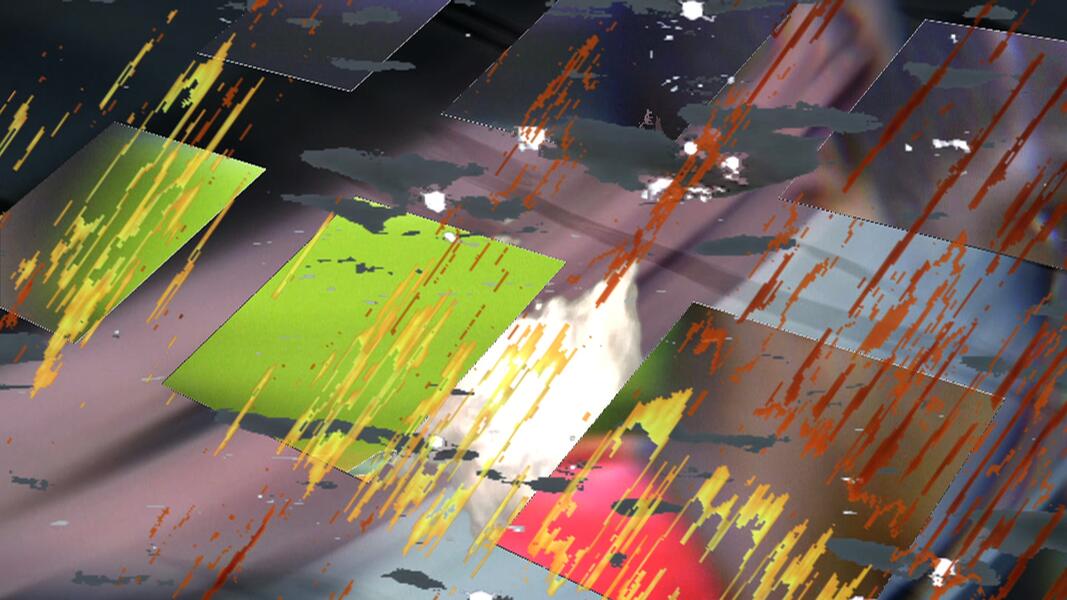 Storm Frames Istill image from video "Frontier" giclee print on canvas, 30" x 53" 2011
Storm Frames Istill image from video "Frontier" giclee print on canvas, 30" x 53" 2011 -
After the Stormsvideo, 2011
-
Kings Highway/Stillwell Ave., Brooklynvideo, 2010
-
Pranayama, Part 3video, 2010
-
Wetvideo 2012
-
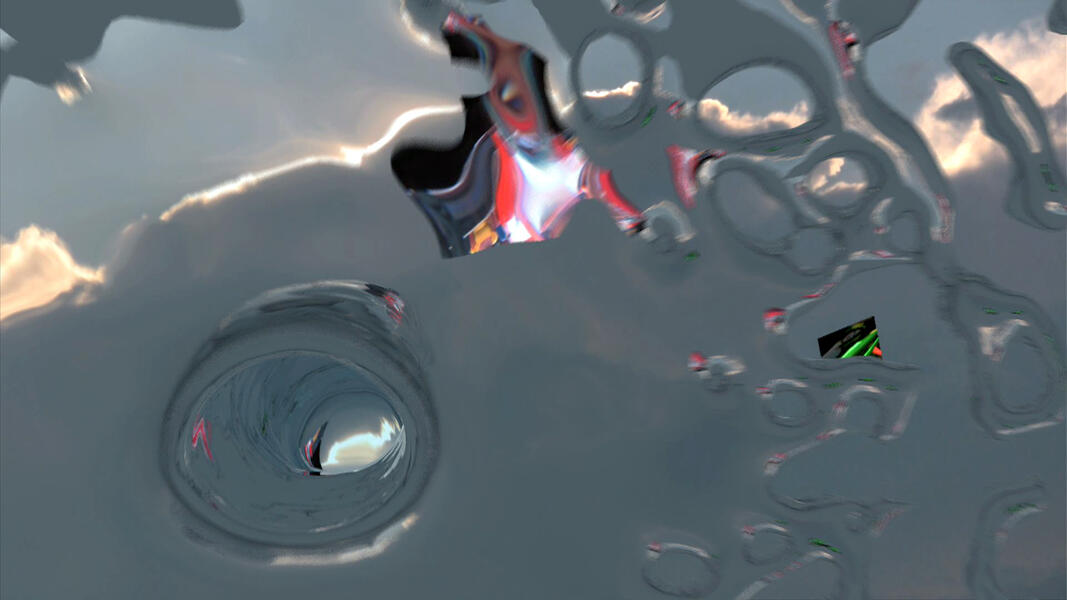 Wetvideo still 2012
Wetvideo still 2012 -
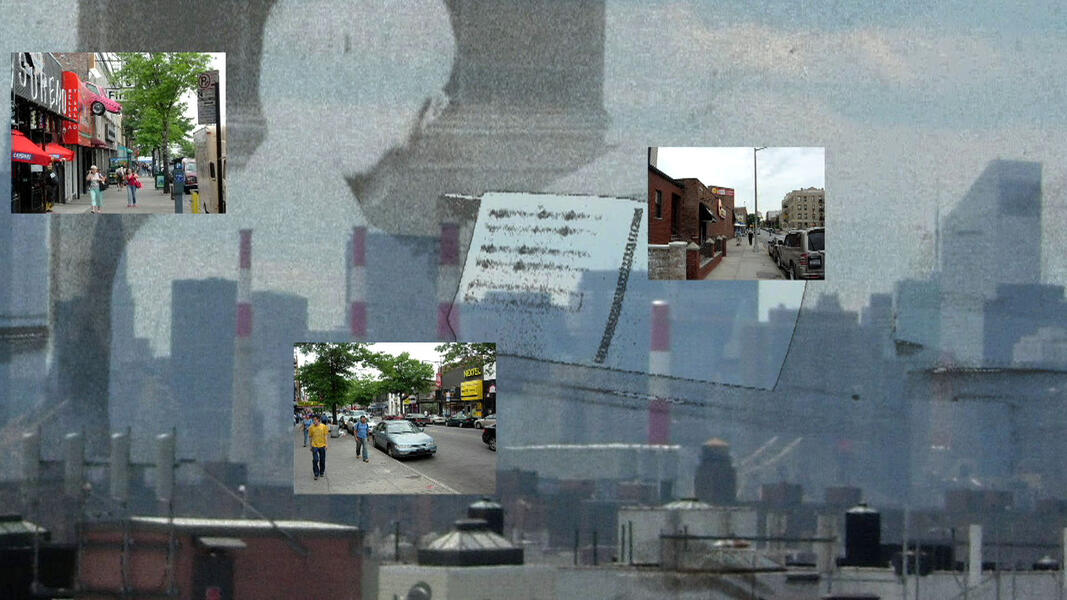 Kings Highway/Stillwell Ave., Brooklynvideo still 2011
Kings Highway/Stillwell Ave., Brooklynvideo still 2011 -
 Directed Youthstill image from video "Frontier" giclee print on canvas, 30" x 53" 2011
Directed Youthstill image from video "Frontier" giclee print on canvas, 30" x 53" 2011 -
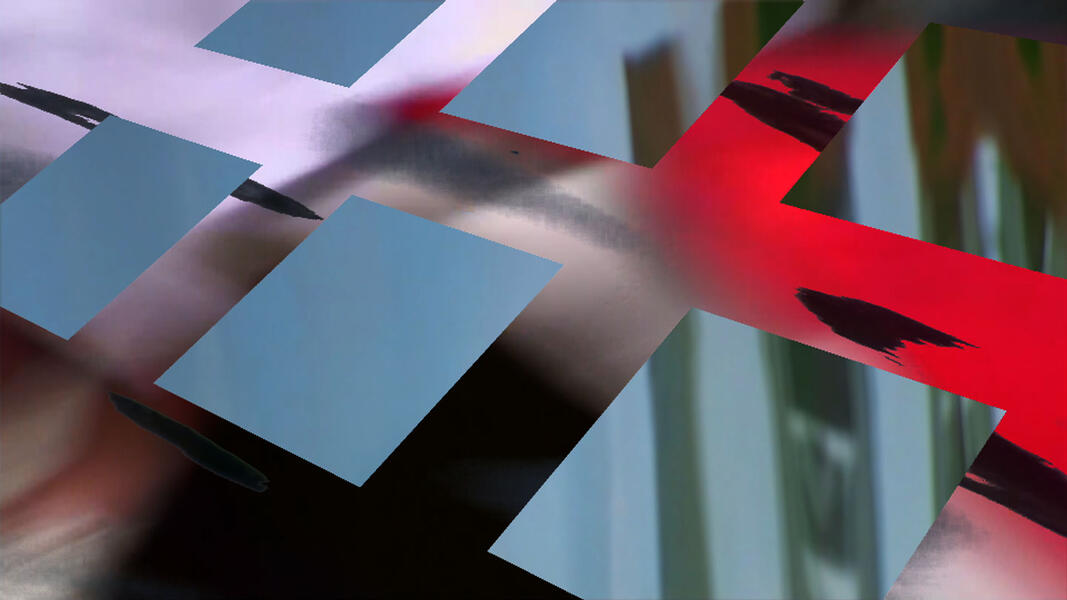 Material Airstill image from video "Frontier" giclee print on canvas, 30" x 53" 2011
Material Airstill image from video "Frontier" giclee print on canvas, 30" x 53" 2011
Recent Video III: 2006-2010
In "Mexico Painting", I followed a similar approach to the one I employed when making "Barcelona Mosaics". The visual and audio imagery derives from footage I shot while on a trip to Mexico in 2006. As in "Barcelona Mosaics", each camera shot contains an edge or boundary that diagonally bisects the frame. All sound is that which accompanied the original visual footage - other than some slow motion manipulation at some points, the original sound is not altered in any way. Because most edits are very rapid, sound and visual material more closely resembles musical beats than representations of specific locations.
"Mexico Painting" was a Rosebud Film & Video Competition finalist in 2008 and was screened at the Maryland Film Festival in 2007. "Barcelona Mosaics" was selected for the Avant Garde Shorts program at the Maryland Film Festival in 2009.
Throughout the period I've been making video art, I've returned again and again to the notion that the video medium can provide me with the means to create a kind of "painting in time". For many years, I've been fascinated by the way various video editing techniques have allowed me to create musical compositions in a rhythmic sense. In the 80's, I utilized many types of analog editing facilities to create a body of work that I referred to as "visual music". I'm continuing to work in this vein, now utilizing a range of digital editing techniques to achieve the results that interest me.
"Cicada Songs, I-III" demonstrates my ongoing interest in rhythmic collage. As in earlier such works, I adamantly maintain a few ground rules related to the gathering of audio and visual material utilized in the final work: 1) there is no overdubbing of audio material; that is, all sounds heard are those originally recorded during video shooting; 2) no manipulations to either audio or visual material occurs during editing; that is, although sequences of video material are often re-scaled and layered together, I haven't altered the image or sound quality of any individual shot. In short, I am drawn to the idea of creating a kind of rhythmic collage by using all the raw, ambient audio that originally accompanied the visual footage I shot in the field. For this piece, I shot all source material the summer of 2004 during the cicada visitation to the Baltimore area. Their sound is present in all audio that I recorded in the field, and so I titled the piece accordingly.
"Cicada Songs I-III" was screened at the Maryland Film Festival in 2006.
Early video I: Forest Dream Code & Quantum Dream
"Forest Dream Code" is a 9-minute single-channel video that's based on an initial 2-screen video installation I created for the "Dada/Data" exhibition held jointly at the UMBC Center for Art & Visual Culture and Maryland Art Place in 1991. In this work, I blend forest and carnival scenes with quotations from Henry David Thoreau and Octavio Paz, along with music by Charles Ives, to evoke a sense of man's growing separation from nature.
I produced "Quantum Dream" in collaboration with musician/composer Mark Pierson and dance choreographer Betty Fain in 1986. The underlying content of the video was inspired by the movement to ban nuclear weapons which was quite active at this time. Lynne Carrachino dances in a "post-apocalyptic" world, and Mark Pierson's music evokes an occasionally hopeful, but generally mournful and somber tone in keeping with the anti-nuclear theme.
Early Video II: Leaving The Ground & Driving in Mexico
"Leaving The Ground" received The Stuart Rome Prize as the "Best Maryland Work" entered in the 20th Annual Baltimore Independent Film and Video Makers Competition in 1989. It's been screened in numerous other festivals nationally.
In 1990, I expanded the approach I explored when making the video "Leaving the Ground" by constructing a video installation entitled "Driving in Mexico". The installation consists of 4 separate video tracks playing simultaneously over 8 TV monitors. The monitors are built into an 8' x 24' mural wall, with one small monitor set into the surface of a projector monitor.
To begin the entire process of this project, I worked on a series of paintings while I was living in Mexico. Then when I returned, I made the "Leaving the Ground" video and "Driving in Mexico" installation.
The paintings visualize the view of someone driving through various areas of Mexico. I built into the surface of these paintings a series of images - two Mexican lotteria cards and two lenticular photos depicting driving in the US. I wanted these images to representation the kind of distraction we sometimes have when driving - the way dream and memory can momentarily overtake our attention to driving.
-
Leaving The Groundvideo, 1988
-
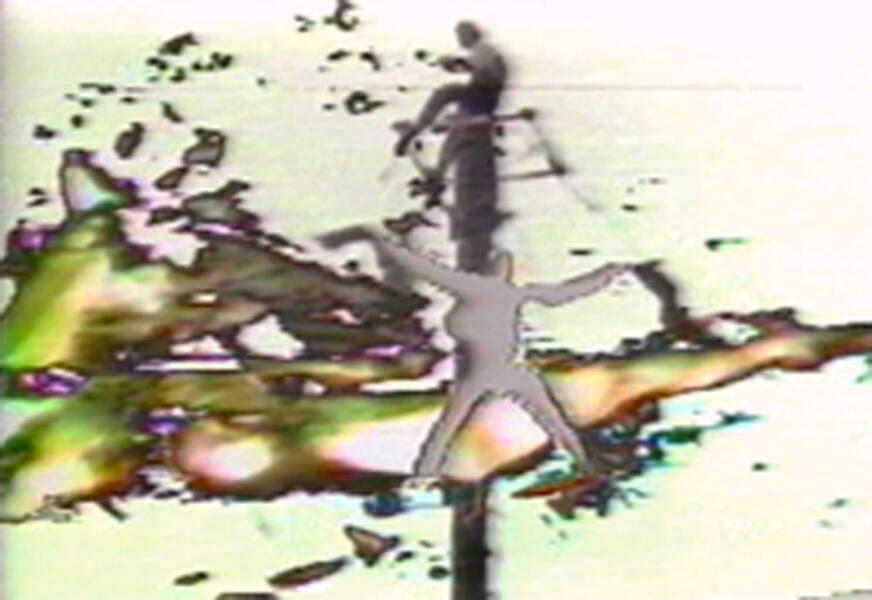 "Leaving the Ground: 3rd Dream - Taking Flight"video still
"Leaving the Ground: 3rd Dream - Taking Flight"video still -
Driving in Mexico: A Video Muralvideo documentation of video installation, 1992
-
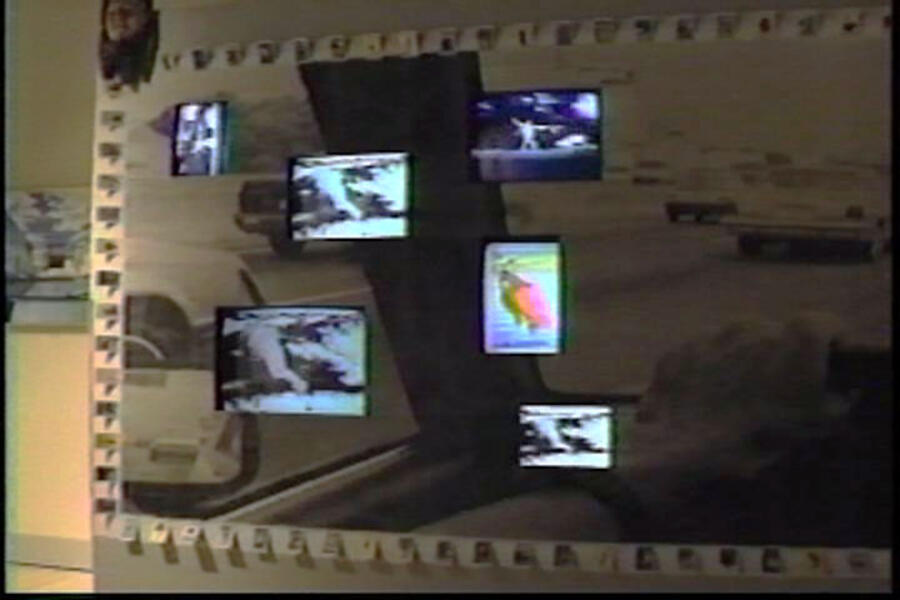 "Driving in Mexico: A Video Mural", 1990video still of documentary
"Driving in Mexico: A Video Mural", 1990video still of documentary -
 "Driving in Mexico: A Video Mural", 1990video still of documentary
"Driving in Mexico: A Video Mural", 1990video still of documentary -
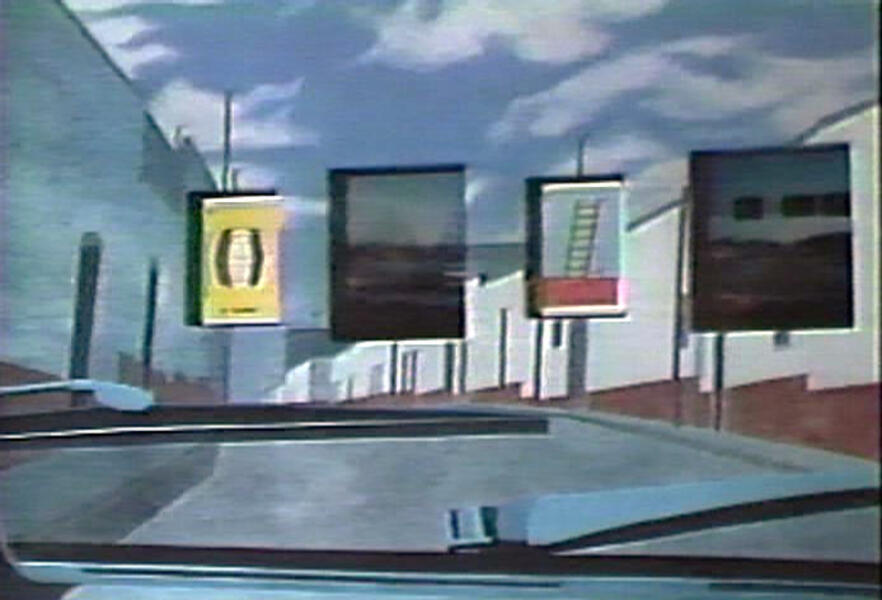 Driving in Mexico paintings, 1986video still of documentary
Driving in Mexico paintings, 1986video still of documentary -
Driving in Mexico paintingsvideo documentation of "Driving in Mexico" paintings on canvas, 1990
-
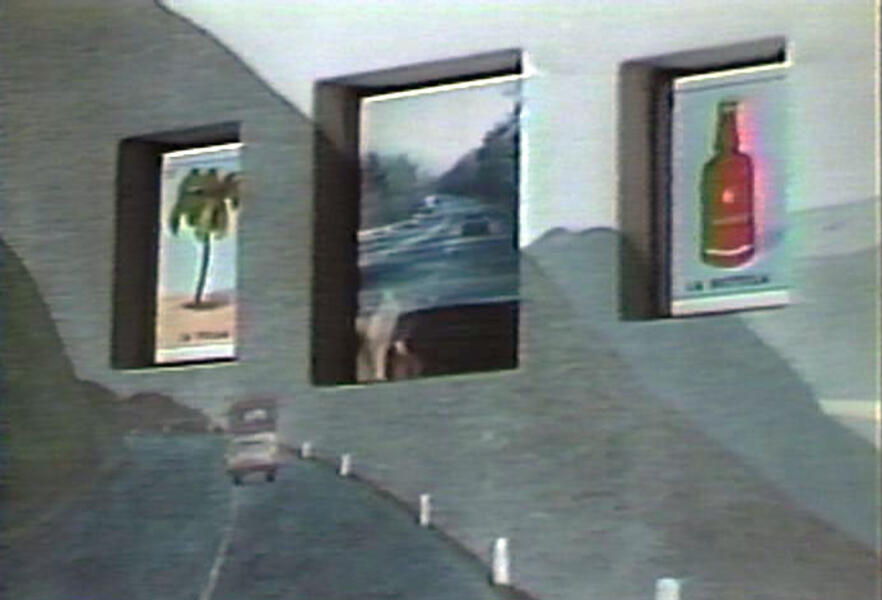 Driving in Mexico paintings, 1986video still of documentary
Driving in Mexico paintings, 1986video still of documentary -
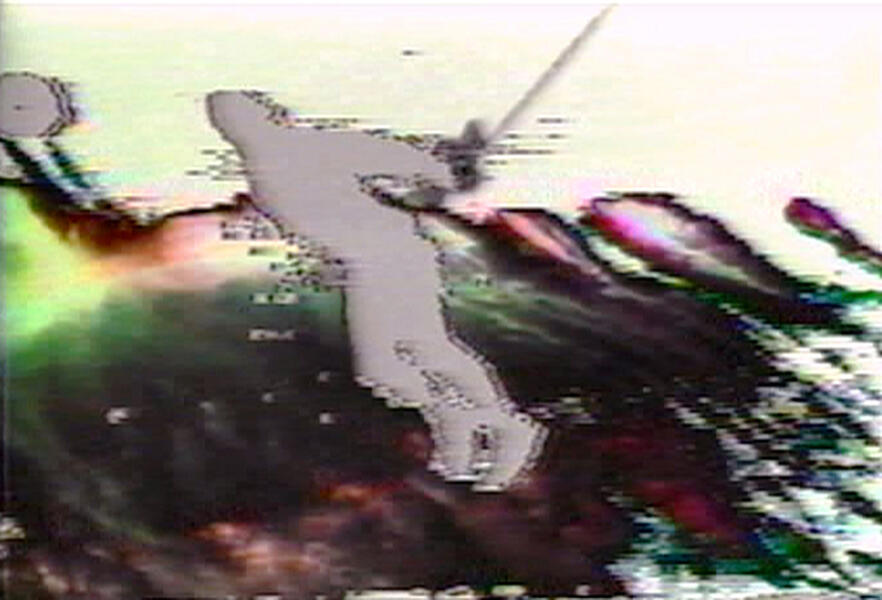 "Leaving the Ground: 3rd Dream - Taking Flight""video still
"Leaving the Ground: 3rd Dream - Taking Flight""video still
Early Video III: 8 Short Processes & Homage to the End of Analog TV: 8 Short Processes
Most of all, what unifies these works is my interest in found sound. I adamantly hold on to all the ambient sound that accompanies the visual element when shooting my video, and, at this time, my interest was in creating collage-like visually musical compositions, which I began referring to as "painting in time". It's this early phase of my videomaking career that strongly influenced the approach I take in some of my most recent works, such as "Cicada Songs", "Mexico Painting", and "Barcelona Mosaics".
-
Joy Ridevideo, 1980
-
Fiandacavideo, 1981
-
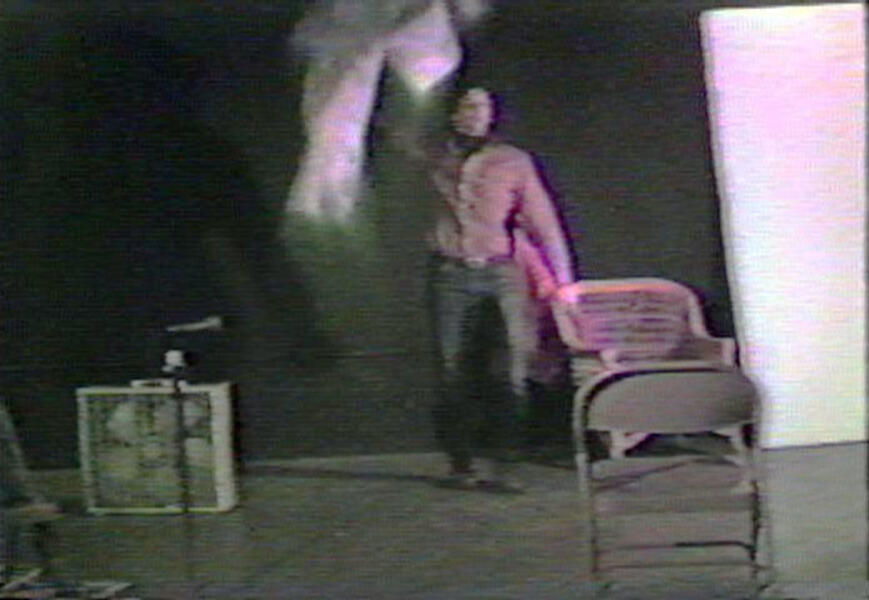 8sp-4.fiandaca-a
8sp-4.fiandaca-a -
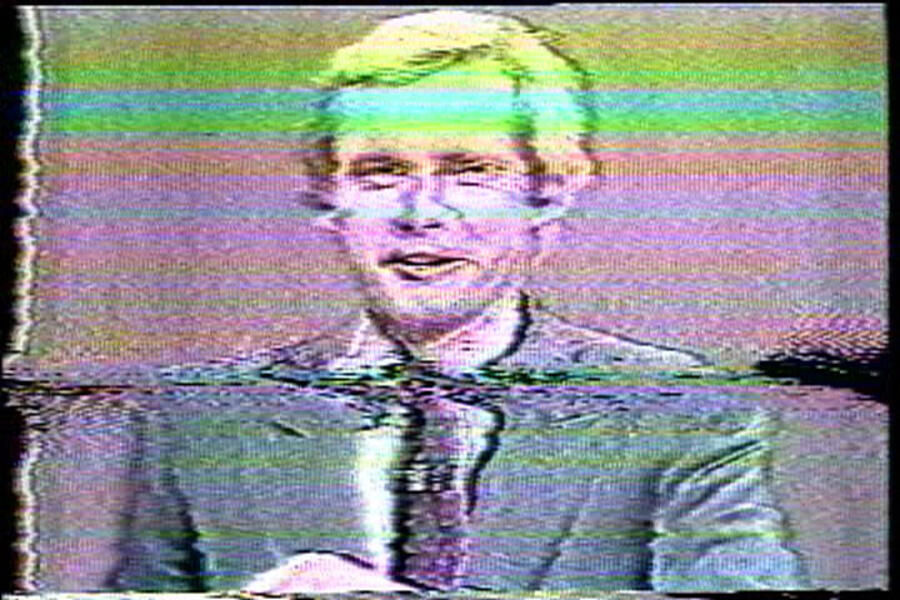 Energy"Energy" demonstrates the effects of analog video editing, specifically the deterioration that occurs to the image when a short video clip is edited back and forth between two tapes 28 times.
Energy"Energy" demonstrates the effects of analog video editing, specifically the deterioration that occurs to the image when a short video clip is edited back and forth between two tapes 28 times. -
Car Songvideo, 1980
-
Water Paintingvideo, 1992 One sequence of rhythmically edited video is superimposed into the shadow of a large rock in the water, and another sequence is superimposed into the water surrounding the rock's shadow.
-
Welk Womenvideo, 1981 I shot the "Lawrence Welk" television show through a large lens and edited sound and visual together to create this alternative Welk Women music video.
-
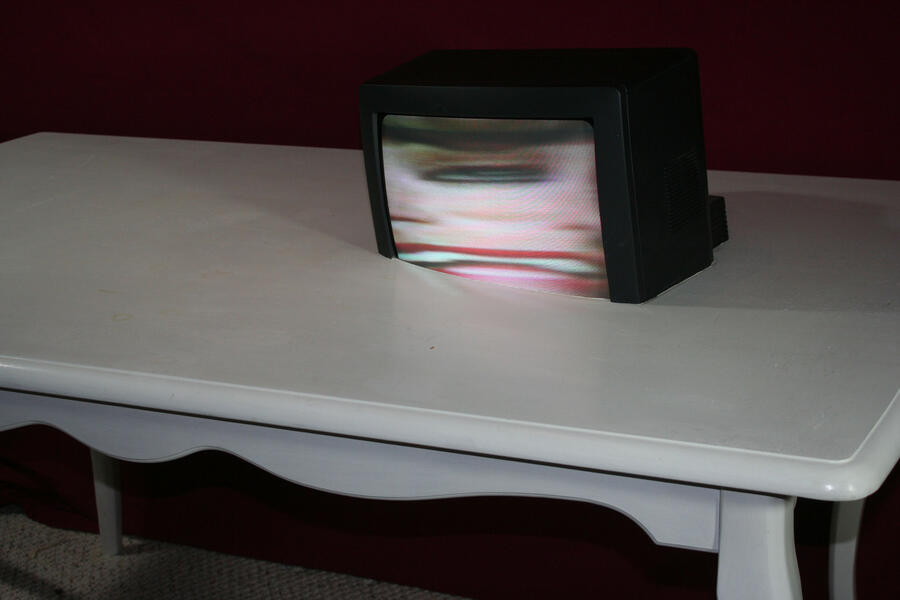 "Homage to the End of Analog TV: 8 Short Processes"Detail of video installation "Homage to the End of Analog TV: 8 Short Processes". Video monitor playing "8 Short Processes" sunk into surface of table, "Dead Air" video art exhibition, Metro Gallery, Baltimore, MD, February 17-March 22, 2009
"Homage to the End of Analog TV: 8 Short Processes"Detail of video installation "Homage to the End of Analog TV: 8 Short Processes". Video monitor playing "8 Short Processes" sunk into surface of table, "Dead Air" video art exhibition, Metro Gallery, Baltimore, MD, February 17-March 22, 2009 -
Crestvideo, 1980 I edited together several takes of my speaking the Crest slogan, each with a slight shift in head position.
-
Energyvideo, 1980 a study of deteriorating video signal. What technical process do I use to create this gradation of descending deterioration?
Collaborations I: Paula Josa-Jones and Mary-Averett Seelye
Since 1992, I’ve had the privilege to collaborate on several video projects with Washington, D.C. performance artist Mary-Averett Seelye. We produced a range of video productions of her choreographed bodily performances of poetry from 1992-1998, and I’m including here four poems by Maryland poet Josephine Jacobsen that Mary-Averett interpreted.
-
EpiphaniesChoreographed and danced by Paula Josa-Jones.
-
TrembleChoreographed and danced by Paula Josa-Jones, music by Gamelan Semar Pegulingan.
-
TribeChoreographed by Paula Josa-Jones; danced by Kate Kilbourne, Marianne Kubik, Mark O. Pugh, Nick Shaw, Cathy Skove, and Elizabeth Witham.
-
"The Edge""The Edge", "Pondicherry Blues", and "A Reason of Numbers" are poems written by Baltimore poet Josephine Jacobsen, and D.C. performance artist Mary-Averett Seelye interprets Jacobsen’s poems, among others, through her bodily movements. Mary-Averett has presented poetry for many years by performing choreographed movements of her body while she speaks a particular poem. In collaboration with Julie Simon, I produced a 30-minute program, "Poetry Moves", that presents performances by Mary-Averett Seelye of Jacobsen's poetry, along with interview sequences of Mary-Averett and Josephine. As Mary-Averett is interpreting Josephine's poetry, I am interpreting Mary-Averett's performances by utilizing the video medium in various ways to extend what Mary-Averett is doing. My goal with this project, as well as with other collaborative projects in which I've engaged with performing artists, is to present the performance in a way that would not be possible live on stage in front of an audience.
-
"Pondicherry Blues" (video art version)Mary-Averett Seelye performs this poem by Josephine Jacobsen, while two sets of imagery suggestive of the poem's narrative content, are superimposed inside and outside her body.
-
"Pondicherry Blues" (performance art version)"Pondicherry Blues" is another poem by Josephine Jacobsen interpreted by Mary-Averett Seelye. Because Josephine wrote the poem with a notated rhythmic beat, intending the poem to be read in a poetry bar, we staged Mary-Averett's performance to resemble such an environment in a Baltimore production studio. Michele Humphries provides the beat on a snare drum. Mary-Averett's goal is to embody the meaning and rhythm of the poem through her choreographed and rehearsed bodily motions.
-
"Reason of Numbers""Reason of Numbers" is a poem written by Baltimore poet Josephine Jacobsen, and it's interpreted here by Washington, D.C. performance artist Mary-Averett Seelye. Mary-Averett has presented poetry for many years by performing choreographed movements of her body while she speaks a particular poem, a practice she calls embodying poetry. In collaboration with Julie Simon, I produced a 30-minute program, "Poetry Moves", that presents performances by Mary-Averett Seelye of Jacobsen's poetry, along with interview sequences of Mary-Averett and Josephine. As Mary-Averett is interpreting Josephine's poetry, I am interpreting Mary-Averett's performances by utilizing the video medium in various ways. My goal with this project, as well as with other collaborative projects in which I've engaged with performing artists, is to present the performance in a way that would not be possible live on stage in front of an audience. In 1998, "Poetry Moves" received a CINE Golden Eagle Award.
-
"Gentle Reader""Gentle Reader" is a poem written by Baltimore poet Josephine Jacobsen, and it's interpreted here by Washington, D.C. performance artist Mary-Averett Seelye. Mary-Averett has presented poetry for many years by performing choreographed movements of her body while she speaks a particular poem, a practice she calls embodying poetry. In collaboration with Julie Simon, I produced a 30-minute program, "Poetry Moves", that presents performances by Mary-Averett Seelye of Jacobsen's poetry, along with interview sequences of Mary-Averett and Josephine. As Mary-Averett is interpreting Josephine's poetry, I am interpreting Mary-Averett's performances by utilizing the video medium in various ways. My goal with this project, as well as with other collaborative projects in which I've engaged with performing artists, is to present the performance in a way that would not be possible live on stage in front of an audience. In 1998, "Poetry Moves" received a CINE Golden Eagle Award.
Collaborations II: Carol Hess
I produced this document of "Private Property" by combining the output of the performer's camera with video from a 2nd camera positioned near the front of the stage.
A piano work by Stuart Saunders Smith, played by Tom Moore, serves as a musical accompaniment to the performance.
"Shibboleth" is a video dance work produced in collaboration with Carol Hess over a six-month period in 1999. Our intent was to portray dancer Emily Giza in relationship with the emergence of the corn harvest - from the dry, bare earth, through the lush, leafy fullness of growth, to withered, crackling stalks at the end of the cycle. Through the cooperation of the University of Maryland College Park (UMCP) Experimental Agricultural Station in Clarksville, MD, we were able to gain extended access to several corn fields under their care, thereby allowing our plan to take shape.
What we didn't count on when trying to shoot our footage was the degree to which our progress was affected by a severe drought that year. Although the corn was slow to emerge, it did miraculously grow, due, I'm certain, to the expertise of our UMCP friends. The fact that the ground was eternally dry and dusty throughout the growing season, however, added to the visual quality of our footage.
Sylvia Smith contributed greatly to the soundtrack by providing "She", a speechsong that she composed and performed. Sylvia graciously allowed us to integrate her composition into the final edited video.
A few years earlier, I collaborated with Carol on "Changing Room", a 12-minute video in 1995. Neal Woodson provided a wide range of sound material which I edited and overlayed in various ways, to accompany the visual sequences. Carol and I recorded dancers Emily Giza and Eric Jenkins in several indoor and outdoor locations around Maryland. Using rhythmic editing and overlay strategies, our intent was to present a dance work in a way that would not be possible in a live performance.
Collaborations III: Elizabeth Goldring
The first clip in this project array is a 17-minute experimental video documentary, "The Inner Eye: From the Outside In", that I produced in collaboration with poet Elizabeth Goldring September 2024. In this video, we look back on our collaborations from the 1980's, as described below.
For our first video produced in 1985, our intent was to portray some of the day-to-day experiences Elizabeth faces as she copes with deteriorating vision loss due to diabetic retinopathy. Elizabeth described to me the visual artifacts and effects she experienced in various settings, and I attempted to simulate these effects using various video techniques.
In this excerpt, we portray several everyday scenes in Elizabeth's life - walking through a building at M.I.T. (where Elizabeth works), crossing the street, experiencing a laser treatment session, walking again in bright sunlight, and reading with the help of a large print computer device. All scenes are accompanied by excerpts of Elizabeth's poems and journal entries, spoken by Elizabeth.
In addition, once the 21-minute video was produced, Elizabeth and I created an interactive video installation inspired by the video, "EYE/SIGHT", featuring a live camera and two-channel (one small screen set into a larger screen) video display. When a viewer sat in an "examination" chair, he/she was able to peer into a camera lens that was set to insert a close-up image of a his/her eye into the video mix. The inner video screen showed edited footage of Elizabeth's diagnostic eye exams, and the outer video screen showed video footage of retinal images until a viewer sat in the chair, at which point the outer screen switched to a live video image of the viewer's own eye. Audio from the diagnostic footage is projected into the space, but when a viewer puts on a set of available headphones, the ambient audio is muted, and the voice of Elizabeth speaking poems from her Eye Journals can be heard.
"EYE/SIGHT" was exhibited in the 1990 "Options" show at the Washington Project for the Arts (WPA), as well as in exhibitions in New York and Germany. "The Inner Eye: From The Inside Out" has been exhibited in numerous exhibitions in this country and Europe.
Included in this project array are 5 excerpts of simulated views of the 2-screen array that was the basis of the installation. As the last entry, a short video documents how a viewer interacts with the installation.
-
The Inner Eye: From The Outside In
Poet Elizabeth Goldring and video artist Vin Grabill remember their video projects from the late 1980's in a conversation recorded at the Goldring-Piene Art Farm in Groton, MA, July 2024.
-
The Inner Eye: From The Inside Out1988
-
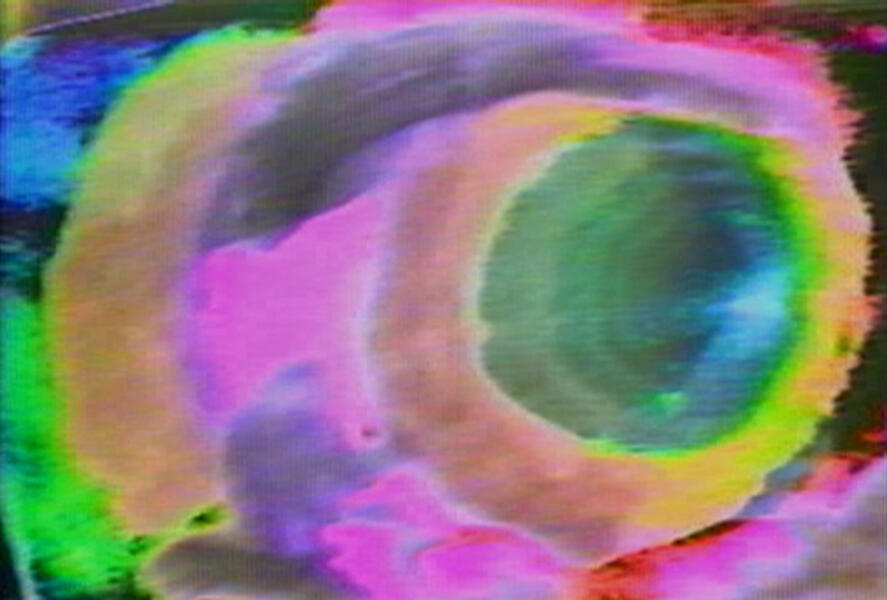 "The Inner Eye: From The Inside Out"video still
"The Inner Eye: From The Inside Out"video still -
EYE/SIGHT installationvideo documentation of "EYE/SIGHT" installation, 1990
-
EYE/SIGHT, excerpt 5excerpt of digital simulation of video installation 1990
-
EYE/SIGHT, excerpt 4excerpt of digital simulation of video installation 1990
-
EYE/SIGHT, except 3excerpt of digital simulation of video installation 1990
-
EYE/SIGHT, excerpt 2excerpt of digital simulation of video installation 1990
-
EYE/SIGHT, excerpt 1excerpt of digital simulation of video installation 1990
-
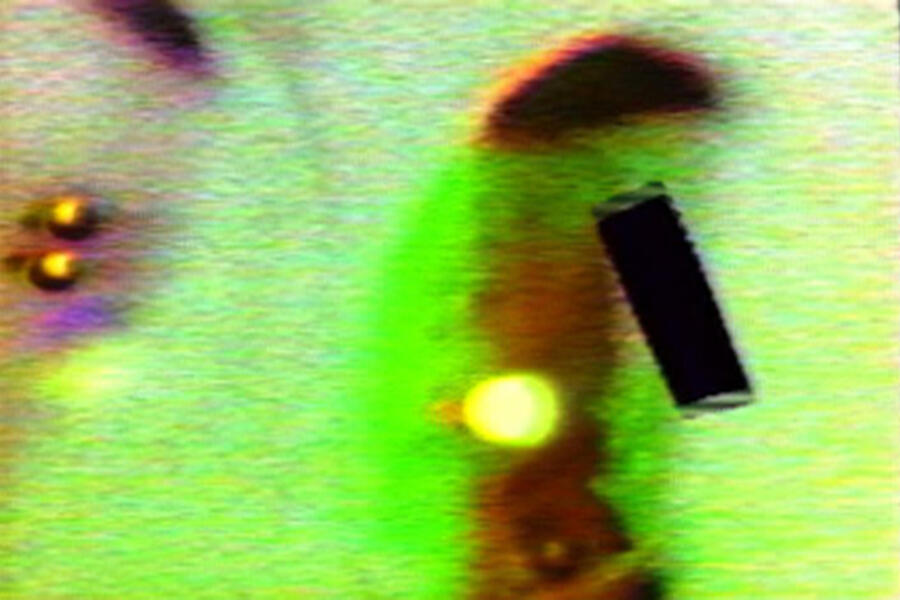 "The Inner Eye: From The Inside Out"video still
"The Inner Eye: From The Inside Out"video still
Performance Art Documentary Video
-
"Sky Kiss - Linz"Otto Piene brought Charlotte Moorman to the Sky Art Conference/Ars Electronica in Linz, Austria in 1982 to perform "Sky Kiss". With the assistance of many volunteers, an array of helium-filled tubes was gathered together, and Charlotte and her cello were lifted off the ground in the vicinity of the Danube River. The video begins with an interview I made of Charlotte on the roof top of her New York studio in 1982, just prior to the performance in Austria.
-
"Otto Piene's Sky Art"For the past 40 years, Otto Piene has pioneered a kind of environmental art he terms Sky Art. This documentary surveys several of Otto's well known Sky Art works, ranging from his "Olympic Rainbow", made for the Munich Olympiad in 1972, to "Sky Kiss" with Charlotte Moorman at the Sky Art Conference in Linz, Austria. Otto adds commentary, along with former Dean of the MIT School of Architecture and Planning, Bill Mitchell. This video was commissioned by the DeCordova Museum, Lincoln, MA, to accompany an exhibit of Otto's work in January 2010.
-
"Otto Piene's Sun Valley Neon Rainbow"This video documents Otto Piene's 1985 large-scale environmental art event in Sun Valley, Idaho - an attempt to install a temporary inflatable sculpture into the picturesque landscape of the Sun Valley hills. Once the inflatable "rainbow" form is prepared and moved into position, with the help of a large crew of volunteers, hundreds of tri-color neon tubes are hung from the central tube, and the rainbow is ready for nighttime viewing. I shot and edited this video documentary in 1985. This is a 10-minute version that I recently edited from the original 48-minute version.
-
"Sky Kiss - Desert Sun/Desert Moon"Four years after Otto Piene collaborated with Charlotte Moorman on "Sky Kiss" at the 1982 Sky Art Conference in Linz, Austria (see "Sky Kiss - Linz"), Otto and Charlotte worked together again on "Sky Kiss", this time in the California desert. The event was part of a week of environmental art works, called "Desert Sun/Desert Moon", created by artists, scientists, and engineers from the Center For Advanced Visual Studies at M.I.T., and transported to the desert near the Alabama Hills of California. Unlike "Sky Kiss - Linz", this version of "Sky Kiss" took place at night. One can never predict how nature will cooperate with such an environmental art work of this scale, and in this case, wind became a fickle variable, sometimes allowing Charlotte and her cello to soar high off the desert floor, sometimes preventing her from launching at all. I recorded this event using SVHS video, along with some Super 8 color and black & white film.
-
"Cut Piece"Charlotte Moorman performed this version of Yoko Ono's "Cut Piece" at the ORF Television Studios in Linz, Austria, for the Sky Art Conference/Ars Electronica in 1982. This is one of a series of performances by Charlotte Moorman and Nam June Paik that took place for this event (see "Sky Kiss - Linz"). I was fortunate to have the opportunity to record these performance art works on video for M.I.T.'s Center For Advanced Visual Studies.
-
"Variations on a Theme by Saint-Saens", by Nam June PaikI documented this version of Charlotte Moorman performing Nam June Paik's "Variations on a Theme by Saint-Saens" at the ORF Studios in Linz, Austria, on the occasion of the Sky Art Conference/Ars Electronica in 1982. This, and other performance art works by Paik and Moorman, were produced by the Center For Advanced Visual Studies, MIT, Cambridge, MA, under the coordination and vision of then-director Otto Piene. "Variations" represents one of Paik's best examples of Fluxus-based performance art. This, and two other of my videos documenting Charlotte Moorman’s performance art work, were included in the exhibition “A Feast of Astonishments: Charlotte Moorman and the Avant-Garde” at the Block Museum, Evanston, IL and the Grey Art Gallery, New York, 2016.
-
"Silver Light Dance/25 Years"This performance art work was created by Otto Piene on the occasion of the 25th anniversary of the Center for Advanced Visual Studies at MIT in 1994. Seth and Noah Riskin perform in their reflective light suits against a backdrop of Otto's silver inflatable sculpture and Joan Brigham's steam screens.
-
Portrait of Aldo TambelliniI made this portrait of video art pioneer and poet Aldo Tambellini in 1980 when I was a graduate student at the MIT Center For Advanced Visual Studies and Aldo was a research fellow.
-
"Aqua Mirage - Laser Projections on Steam by Paul Earls"This video documents experiments with laser projections on water screens. Paul Earls takes drawings of fish by Otto Piene and programs a laser to project them onto water screens by Joan Brigham at the Center For Advanced Visual Studies at M.I.T. In addition, Paul's music interacts with with scanning of the laser beams, causing the drawings to jump and dance.
-
Interfaces: Cambridge – Paris, 1981I documented this telecommunication event between artist groups in Cambridge and Paris on February 1, 1981. Both groups transmitted a series of fragmented images depicting both countries’ presidents by means of slow-scan television. These images were then photographically enlarged and assembled to form 6’ x 8’ murals of Ronald Reagan and Giscard D’Estaing in a presidential exchange. Artists Aldo Tambellini and Roland Baladi crossed the Atlantic to supervise activities at the American Center in Paris and the Center for Advanced Visual Studies (CAVS) in Cambridge.

